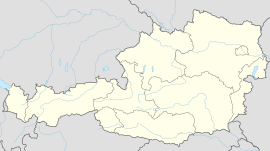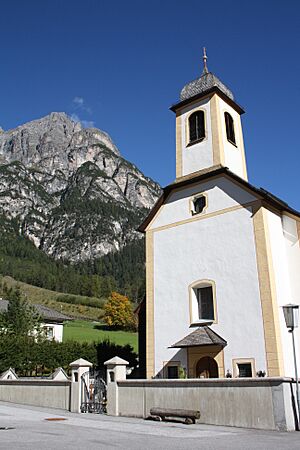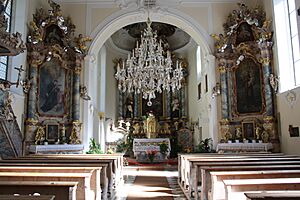Gschnitz facts for kids
Quick facts for kids
Gschnitz
|
||
|---|---|---|
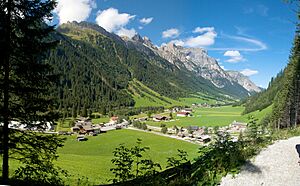 |
||
|
||
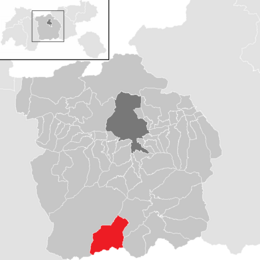
Location in the district
|
||
| Country | Austria | |
| State | Tyrol | |
| District | Innsbruck Land | |
| Area | ||
| • Total | 59.12 km2 (22.83 sq mi) | |
| Elevation | 1,242 m (4,075 ft) | |
| Time zone | UTC+1 (CET) | |
| • Summer (DST) | UTC+2 (CEST) | |
| Postal code |
6150
|
|
| Area code | 05276 | |
| Vehicle registration | IL | |
| Website | gschnitz.tirol.gv.at | |
Gschnitz is a small town in the south of North Tyrol, a region in Austria. About 415 people lived here as of 2011. It's known for its beautiful valley and rich history.
Contents
Where is Gschnitz?
Gschnitz is located at the very end of a valley that shares its name. This valley branches off from the larger Wipptal valley near a town called Steinach am Brenner. The area is surrounded by mountains. The town's borders reach all the way to South Tyrol, which is a part of Italy. The village gets its fresh drinking water from the Gschnitz Brook.
Other towns close to Gschnitz include Brenner, Neustift im Stubaital, Obernberg am Brenner, and Trins.
A Look at Gschnitz's Past
How Gschnitz Started
Gschnitz was first mentioned in official records way back in 1284. It was called "Gasnitz" then. In 1288, the valley had nine special mountain farms, known as Schwaighöfe. Seven of these farms were in Gschnitz itself, forming the heart of the village. These farms were so important that they helped create the rules for how land was passed down in the Tirol region. These rules were later used in other valleys too.
In 1471, there was a big disagreement between Gschnitz and the nearby village of Trins. It got so serious that people from both villages blocked the valley entrance! The local court in Steinach am Brenner had to step in to solve the problem. Gschnitz officially became its own municipality, or town, in 1811. The town really started to grow and develop from the 1700s onwards.
Gschnitz's Coat of Arms
Every town has a special symbol called a coat of arms. Gschnitz's coat of arms has a red background. Across it are three horizontal stripes. Each stripe is made up of six diamond shapes, alternating between white and black. This design looks a bit like the roofs of those old mountain farms. This special coat of arms was made official on January 10, 1984.
Population Over Time
| Historical population | ||
|---|---|---|
| Year | Pop. | ±% |
| 1869 | 210 | — |
| 1880 | 222 | +5.7% |
| 1890 | 221 | −0.5% |
| 1900 | 194 | −12.2% |
| 1910 | 217 | +11.9% |
| 1923 | 207 | −4.6% |
| 1934 | 230 | +11.1% |
| 1939 | 246 | +7.0% |
| 1951 | 278 | +13.0% |
| 1961 | 291 | +4.7% |
| 1971 | 371 | +27.5% |
| 1981 | 436 | +17.5% |
| 1991 | 443 | +1.6% |
| 2001 | 455 | +2.7% |
| 2011 | 415 | −8.8% |
The population of Gschnitz has changed over many years. In 1869, there were 210 people living there. The number grew steadily for a long time, reaching its highest point in 2001 with 455 residents. By 2011, the population was 415.
Places to See
Our Lady of Snow Parish Church
Long ago, Gschnitz was part of a larger church area based in Matrei am Brenner. The church in Gschnitz, called "Our Lady of the Snow," was built in 1730. Later, in 1755, it was updated in the fancy Baroque style. The plans for this beautiful redesign were made by an architect named Franz de Paula Penz. In 1775, Gschnitz got its own church leader, called a Vicariate. Then, in 1891, it officially became its own parish, which means it had its own main church and priest.
St. Magdalena Sanctuary
The Sanctuary of St. Magdalena is a very old and special church. It's located high up in the mountains, about 1,661 meters (5,450 feet) above sea level. You can only reach it by walking! It sits near the border between Gschnitz and Trins, under a mountain called Schönberg. This church is the oldest in the valley. We know this because old paintings, called Romanesque frescoes, were found inside in 1959. These paintings date back to around the year 1200!
See also
 In Spanish: Gschnitz para niños
In Spanish: Gschnitz para niños



